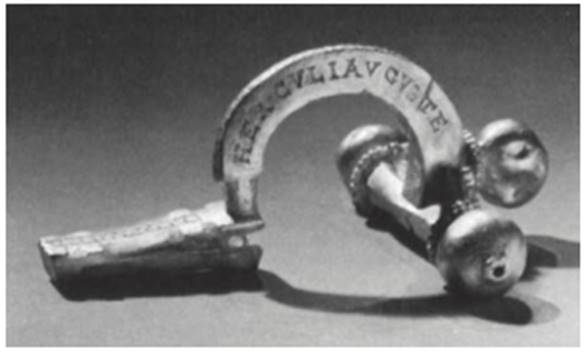Fibula. Italy (?), 300-310. Gold
Twisted when it came to the Metropolitan Museum, the fibula was reshaped in 1965, but still shows signs of damage. A ring of beaded wire is missing at the junction of the bow to the catchplate, and the pin is also gone. This fibula, a pin to clasp a man's cloak at the right shoulder, consists of crossbar, catchplate, and bow. The crossbar is hexagonal, hollow, and ornamented on the top with a pair of cut-out dolphins. On the underside is an opening where the missing pin was once hinged.

The catchplate, also hollow, is slit down one side to receive the pin. The bow-shaped centerpiece, trapezoidal in cross section, is joined to the catchplate by an intervening peg, a somewhat naked junction once dressed up by a beaded collar. Hollow, onion-shaped globes, with collars of beaded wire, are joined to the ends of the crossbar and to the end of the bow. A hatched design is engraved on the top of the bow and catchplate, and an inscription is boldly cut into the bow: hercvli avgvste on one side and semper vincas on the other, "Hercules Augustus, may you always conquer."
When Diocletian created the Tetrarchy in 293 the co-regents, the Augustus and Caesar of the West, were placed under the divine protection of Hercules, those of the East, under the protection of Jupiter. It is not possible to decide, however, whether the inscription refers to Maximian, who bore the title Augustus until 305 and then again in 307-308, or to Constantine, Augustus from 307 to 310.
The fibula was found at Arezzo in northern Italy in 1866. Fibulae of this design are numerous in bronze, less common in silver and gold, and of those in gold only seven have inscriptions. The other inscribed gold ones range in date from about 303/304 to 361/363. In style and weight this fibula closely matches one in Turin datable by its inscription, which refers to Constantine as Caesar, to 306/307 (Noll [2], 1974, p. 235).
Gold fibulae as well as silver anniversary dishes (no. 8) were presented by the state to soldiers and high officials on special occasions. Ammianus Marcellinus [History 20.4.18) relates that the emperor Julian promised five aurei and one pound of silver to each man at his accession in 361. The custom of presenting specific amounts of gold and silver in this form originated in the early fourth century and lasted into the sixth. Many gold fibulae are equal in weight to five aurei or to multiples of five—this example weighs ten aurei— and most silver anniversary dishes weigh one pound or multiples of a pound, according to Ammianus. There was a monetary correlation between the amounts of gold and silver given, because with the ratio of silver to gold at about twelve to one, five aurei were worth approximately one pound of silver. Bibliography: Gamurrini, 1868; CIL, 1901, 11, pt. 2, fasc. 1, p. 1171, no. 6711, 1; Oliver, 1966, pp. 283-284; Noll (2), 1974, p. 232.
Date added: 2025-08-31; views: 76;
